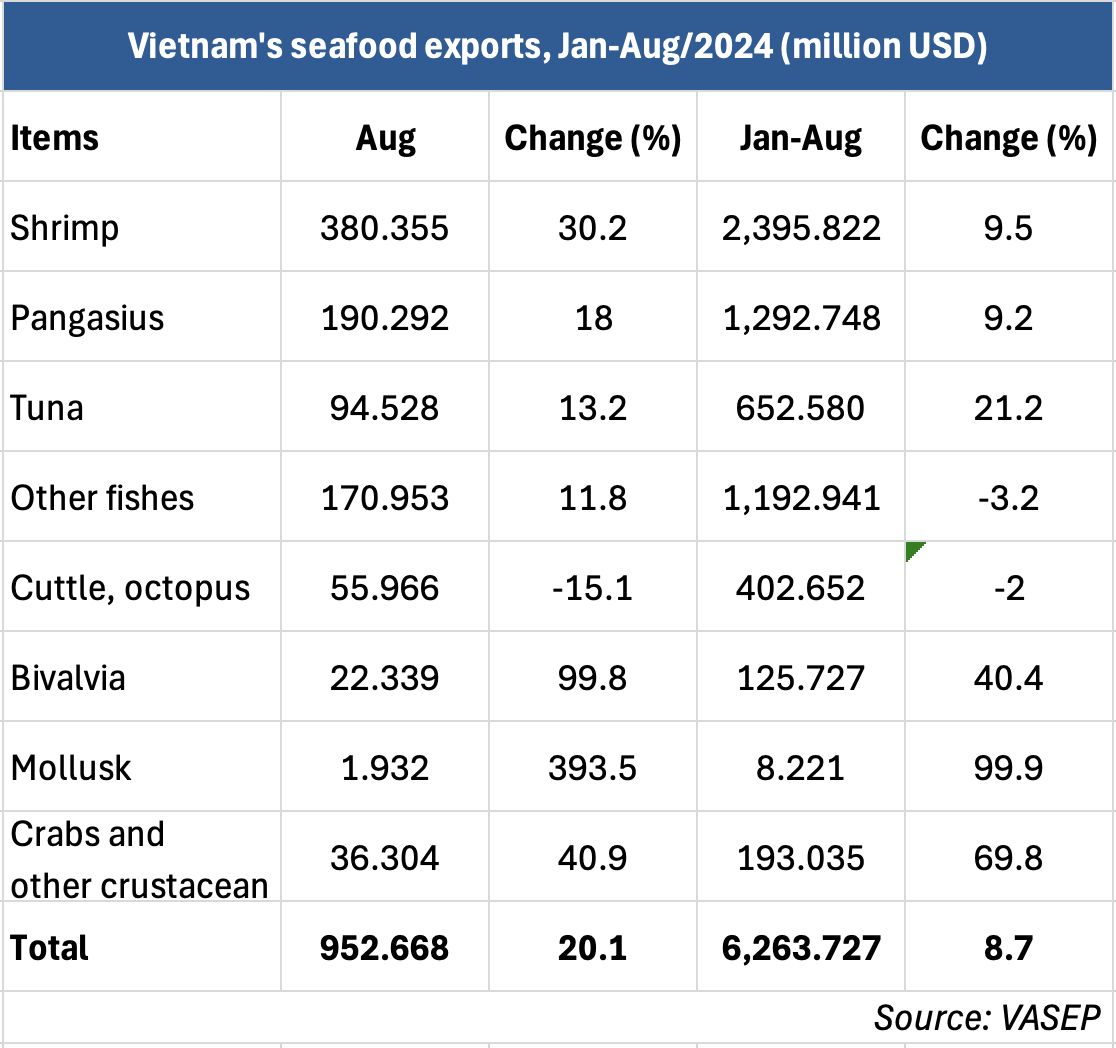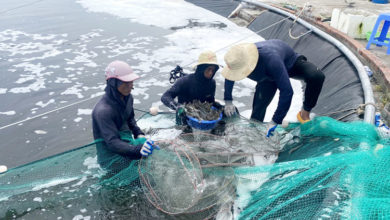Seafood exports in August maintain recovery momentum
In August 2024, Vietnam’s seafood exports continued their upward trend, growing by 20% to nearly USD 953 million.
Over the first eight months of the year, total seafood exports reached close to USD 6.3 billion, reflecting an increase of nearly 9% compared to the same period last year.
While squid and octopus saw a 15% decline in exports in August, all other key seafood products posted strong growth, with some even achieving double or triple-digit gains. Specifically, shrimp exports rose by 30%, pangasius by 18%, tuna by 13%, and other marine fish by 12%.
As of the end of August, shrimp exports totaled almost USD 2.4 billion, up 9% compared to last year. Whiteleg shrimp contributed about USD 1.75 billion, up 8%, while black tiger shrimp exports were still 7% lower year-on-year, reaching nearly USD 290 million. Lobster exports, on the other hand, continued their strong growth in August, with the total for the first eight months up by more than 140% year-on-year.
Despite facing hurdles such as anti-subsidy and anti-dumping duties, shrimp exports have shown a positive outlook, with stable growth in recent months. Following the Vietfish seafood exhibition in August, export prospects could improve further. Additionally, a forecasted decline in global shrimp production for 2024 is expected to push shrimp prices higher. Shrimp production from China, Ecuador, and India is projected to drop, reducing global output by about 260,000 tons (a 5% decrease) to 4.89 million tons. Shrimp consumption has begun to pick up in Europe, and the U.S. market has also shown signs of recovery. Although shrimp prices in China remain low, these are promising signs for the overall shrimp market.
Pangasius exports reached nearly USD 1.3 billion in the first eight months of the year, up 9% from the same period in 2023. While exports to China have stagnated, the recovery of the U.S. market has helped boost pangasius exports. Shipments to the U.S. increased by 23%, while exports to China fell by 3%. The U.S. continues to source whitefish species through its Department of Agriculture’s procurement programs. On August 29, the USDA announced further seafood purchases, including Pacific cod, grouper fillets, and catfish products, with a USD 6.5 million purchase of 1.5 million pounds of catfish. These purchases were distributed among five processors in the Gulf of Mexico region: Alabama Catfish, America’s Catch, Consolidated Catfish Producers, Heartland Catfish, and Magnolia Processing.

Tuna exports totaled USD 652 million by the end of August, a 21% increase year-on-year. Despite continued demand for Vietnamese tuna, the growth rate may slow in the coming months due to a shortage of raw materials. Since the implementation of Decree 37/2024, which mandates a minimum size of 0.5 meters for skipjack tuna, businesses have struggled to source tuna that meets this requirement, resulting in a shortage of domestic supply for canned tuna and other export products.
Squid and octopus exports have been most affected by the IUU yellow card, with difficulties in obtaining catch certifications, leading to a lack of qualified materials for export. Consequently, by the end of August, exports of squid and octopus had dropped 2% year-on-year, amounting to USD 402 million.
In summary, demand for seafood in various markets has been improving, with prices also gradually recovering. However, significant challenges remain, including the IUU yellow card, anti-subsidy duties, and anti-dumping taxes, which may limit growth in the coming months. By the end of 2024, seafood exports are expected to reach between USD 9.4 and 9.5 billion, representing a nearly 6% increase compared to 2023.
VFM






